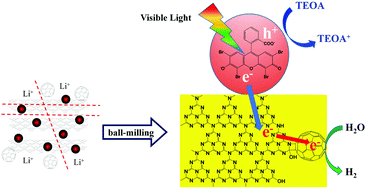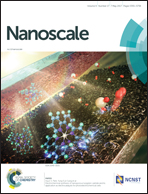A facile mechanochemical route to a covalently bonded graphitic carbon nitride (g-C3N4) and fullerene hybrid toward enhanced visible light photocatalytic hydrogen production†
Abstract
Graphitic carbon nitride (g-C3N4) as an emerging two-dimensional (2D) nanomaterial has been commonly used as a metal-free photocatalyst with potential applications in visible light photocatalytic water-splitting. However, the photocatalytic activity of g-C3N4 is quite low due to its relatively large band gap and the existence of contact resistance between the nanosheets. Herein we report for the first time the facile synthesis of a covalently bonded g-C3N4/C60 hybrid via a solid-state mechanochemical route and its application in photocatalytic hydrogen production under visible light. The g-C3N4/C60 hybrid was synthesized by ball-milling g-C3N4 and C60 in the presence of lithium hydroxide (LiOH) as a catalyst. The hybrid nature and conformation of the g-C3N4/C60 hybrid were confirmed by a series of spectroscopic and morphological studies, featuring the covalent bonding of C60 onto the edges of g-C3N4 nanosheets via a four-membered ring of azetidine, which has never been reported in fullerene chemistry. The g-C3N4/C60 hybrid was further applied to metal-free visible light photocatalytic hydrogen production, affording a H2 production rate of 266 μmol h−1 g−1 without using any noble metal cocatalyst such as Pt, which is about 4.0 times higher than that obtained for the pristine g-C3N4 photocatalyst.



 Please wait while we load your content...
Please wait while we load your content...